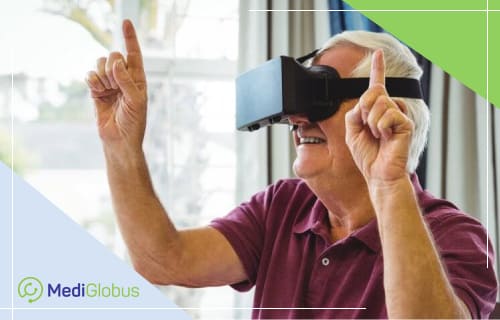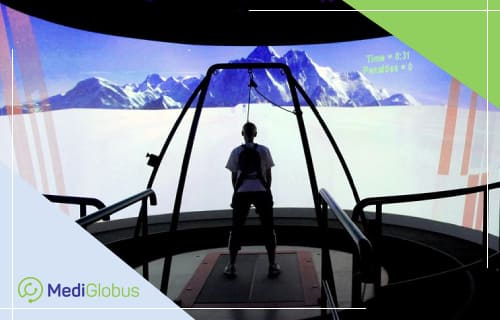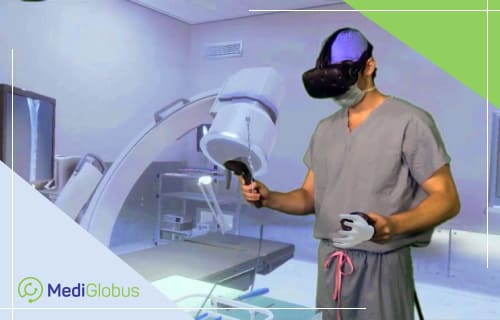Virtual Reality is an innovative technology that uses a special VR helmet and controllers to create the impression of being elsewhere. Over the past decade, these gadgets have become increasingly common not only in the entertainment industry but also in medicine. With the help of virtual reality, doctors are opening up new opportunities in the diagnosis and treatment of common diseases, which was impossible with the old technology. The MediGlobus team has made a selection of 6 most interesting innovations, which are used in modern clinics. In a few years, these inventions may become commonplace.
Early diagnosis of Alzheimer’s disease

Every year more than 10 million people get diagnosed with dementia. It 60-70% of the cases, Alzheimer’s disease is the cause. It is a brain disease common among people over 60 years of age. Its main symptoms are memory loss, difficulties in performing everyday tasks, problems with spoken and written language, changes in mood and personality. Alzheimer’s disease makes life much more difficult, and people with this diagnosis need constant support and care.
There is currently no cure for Alzheimer’s disease. However, doctors use many methods to slow down the progress and give the patient more years of productive life. For example, they use deep brain stimulation (DBS), electromagnetic therapy , or medication.
As with other diseases, the sooner Alzheimer’s treatment is started, the more effective it will be. For this reason, many modern studies aim to detect this disease at its earliest stages.
The new method, which uses virtual reality technologies, allows diagnosing Alzheimer’s disease at early stages more effectively than cognitive tests that neurologists usually use.
The method, developed by the scientists from the University of London, is based on the work of Professor John O’Keefe – Nobel Prize winner in medicine and physiology in 2014. He studied how our brain determines its position in space. The part of the brain responsible for this function is one of the first to suffer from Alzheimer’s disease. Until recently, there was no method to detect this symptom.
The technology offered by the doctors consists of a VR helmet and a connected control system. The person has to perform several tasks that are displayed on the screen. To complete them successfully, they need to have a “mental satnav” – to understand where they are located relative to other objects. This ability suffers in people with Alzheimer’s even before they begin to show memory impairment.
A patient who has difficulty performing such a task can be reliably diagnosed with Alzheimer’s disease.
Early diagnosis of multiple sclerosis with VR
Multiple Sclerosis – a disease in which the human immunity begins to attack their nervous system. The disease affects the myelin membrane of nerve cells, making them slower at transmitting the signals. As a result, patients suffer from symptoms such as fatigue, numbness and tingling, mental disorders, mood instability, balance and gait problems.
Because of nervous system dysfunction, patients with multiple sclerosis have difficulty performing simple everyday activities, such as walking. Due to impaired signal transmission, such people fall more often, which can lead to traumatic situations, especially in old age. Statistics show that even people with multiple sclerosis without symptoms are twice as likely to fall as their healthy peers.
With VR technology, doctors can detect balance disorders before they affect the patient’s life. This makes it possible to start treatment and rehabilitation in advance.

During the diagnosis, the patient is asked to walk the treadmill, wearing a VR helmet on their head. The picture adapts to the movement speed of the diagnosed person. After a while, when the person is used to this environment, the image in the helmet changes, giving an illusion of falling. Since our brain is unable to distinguish between a real and a virtual picture, the body automatically reacts, trying to avoid falling – just as if the person stumbled in real life.
By analyzing the speed and accuracy of the reaction, doctors can detect multiple sclerosis in its early stages. This method of diagnosis is more accurate than previous ones, as in the first stages of the disease imbalance cannot be detected on a normal treadmill. Also, this method is safer – the patient is protected from falling with a special attachment.
The doctors who developed this technology hope to introduce it into diagnostic practice around the world. They’re also working to start using it in multiple sclerosis rehabilitation.
VR technology in Parkinson’s disease rehabilitation

At the same time, doctors have already managed to adapt virtual reality technologies to help patients who suffer from walking problems due to Parkinson’s disease. Like patients with multiple sclerosis, this group of people often suffers from imbalances that often cause them to fall and be injured in everyday life.
Parkinson’s disease is caused by cell changes in the brain. People affected by it begin to suffer from symptoms such as limb tremors, reduced muscle flexibility and slow motion. It is harder to move around in rough terrain, and if the patient stumbles, they won’t be able to react in time.
The method, developed by doctors at the University of Utah, allows patients with Parkinson’s disease to train in a safe medical laboratory environment. The patient is in a small room with a treadmill that can change its pace or angle depending on the required conditions.
A video projector broadcasts a virtual environment on the walls of the room, with the help of which the person can see what kind of obstacle they face – for example, to go down a slide or climb stairs. Adapting to the patient’s needs, the system can provide easier or more complex tasks. By using this simulator, people improve their balance and muscle tone.
Patients who have already undergone rehabilitation using this method note that they had a lot of fun and it was more like a game than training in the gym or a medical procedure. The positive impression was also thanks to the security system, which does not let the patient fall under any circumstances.
Patients who have undergone this rehabilitation course for two months were making significant progress. By using the simulator half an hour a day three times a week, they have been able to improve their balance, navigate around obstacles of different sizes, and achieve greater mobility in the hip and ankle.
In the future, doctors hope to adapt this system to VR helmets, allowing it to be used in more clinics.
Using VR in the treatment of chronic pain
About 20% of the population suffers from chronic pain. The effectiveness of their treatment depends on the cause of the disease. For many years a big issue was the treatment of patients with allodynia – a condition where a normal touch or muscle movement causes severe pain. Therefore, many methods used in the treatment of chronic pain remain inaccessible to this group of patients.
In 2020, doctors developed a method that showed its effectiveness in treating patients with sympathetic reflex dystrophy. By wearing a VR helmet, they enter a virtual reality in which they can see a realistic model of their affected limb. The essence of the treatment is that this image flashes in synch to the heartbeat of the patient. This gives feedback to the brain without causing the treatment to be painful. The invention is called HEVR therapy.
This method is even more effective in combination with medication therapy.
The developers are confident that HEVR therapy will soon be used to treat chronic pain in patients with various diseases, such as fibromyalgia, stroke or amputation of the limb.

Planning operations with virtual reality

Surgeons at St. Joseph’s Children’s Hospital found an original way to use VR technology inpatient care. With the help of special software they upload the results of CT and MRI scans to a computer, and with its help, they create a virtual 3D model of the patient’s body. For this purpose, doctors use technologies that have been successfully used by the U.S. military for several years to train F-16 pilots.
With a VR helmet, the surgeon can create a detailed plan for the operation to be performed. In this way, it is very convenient to get acquainted with all the individual features of the patient’s anatomy, choose the best approach and foresee all possible complications. Besides, the doctor can test various surgical approaches on a virtual model before starting the treatment of the patient.
Often the surgeon can discuss the upcoming surgery with the patient or his relatives, and demonstrate it on the VR model. This helps the patient to better understand their illness and reduces stress and anxiety before surgery.
This technology has already been successfully used by the Cardiology and Neurology Department of the hospital. Doctors are confident that in time their colleagues from other clinics will adopt this practice.
Advanced medical technology companies have already seen the benefits of VR surgery planning. The latest generation of Da Vinci robots can use a patient’s body model in preparation for surgery, and to access it during the procedure itself.
Training surgeons with VR technology
Osso VR is a virtual training method for young surgeons, which is already used in 16 clinics in the United States and Great Britain. It is a “surgeon simulator” program that allows specialists to train in surgery. The doctor works with a realistic model of the patient, on which they need to perform all the same actions as they would in real life.
The program not only provides an opportunity to train before surgery. It also can assess the level of the doctor’s skills – the accuracy of movements, speed of decision-making, the correct sequence of procedures. It can determine whether the doctor is ready to operate or should have additional training.
The experience of the system’s creator shows that surgeons who trained on the Osso VR system were 230% more effective than their colleagues.

VR training can be used not only for young professionals but also for more experienced surgeons who are learning new surgical techniques such as laparoscopic surgery or the da Vinci robot.
The Osso system is already used for training in various orthopaedic and spinal operations. The creators are working to add simulations for heart and internal organs operations.
The young doctors enthusiastically accepted the technology. Only in a few weeks after the initial news, there were many applications to join the program. The developers are confident that their invention will significantly improve the quality and professionalism of surgeons’ training.
In which clinics is it possible to undergo treatment and rehabilitation with the help of modern VR technologies?
Virtual reality is just beginning to be introduced into medical practice. Most clinics that use these methods are in the USA and UK. However, these are countries with some of the highest prices for healthcare. It is much more profitable for medical tourists to visit specialised centres of European, Asian, or Middle Eastern countries. They use the same technologies, but at a lower price – due to the country’s economic policy. The Mediglobus team has compiled a list of such clinics, access to which patients from other countries.
Neurology and Rehabilitation Centre cereneo in Switzerland. This is a unique clinic, which specializes in neurological rehabilitation with the help of innovative technologies. Here, with the help of VR patients are helped to restore mobility of arms, legs, speech and thinking skills.
The network of HELIOS clinics in Germany. Since 2011, doctors practising in these hospitals have been training with virtual reality technology. As a result, the treatment performance of the HELIOS Clinics is several times higher than the German average.
One of the most progressive clinics in Israel is the Assuta Medical Center. Here they use a unique virtual system for diagnostics and rehabilitation of various neurological diseases: Parkinson’s disease, multiple sclerosis, strokes, amputations, spinal cord injuries, phobia and PTSD treatment.
VR technology is actively developing in South Korea. In particular, the University Hospital of Severance has successfully used such techniques in the treatment of psychiatric disorders such as PTSD, panic disorder and ADHD. A variety of virtual programmes have also been used to prepare children before surgery. They have reduced preoperative anxiety by 40%.
Resume
VR technologies are effectively used in modern medical centres. With their help, neurological diseases such as Alzheimer’s disease and multiple sclerosis are already effectively diagnosed.
Virtual reality is used to treated patients with Parkinson’s disease, chronic pain, mental disorders, rehabilitation after injuries and operations.
The world’s leading clinics actively use VR programs to train doctors and plan operations.
Medical VR technology is available in clinics in Switzerland, Germany, South Korea and Israel.
To make an appointment for a consultation with a doctor at a foreign clinic, just click on the “Get a free consultation” button and leave your phone number. Our consultant doctors will call you back, answer all your questions, as well as help with organizing the trip and treatment.





